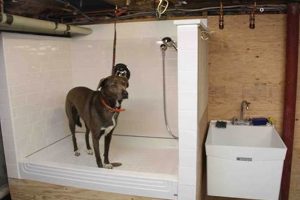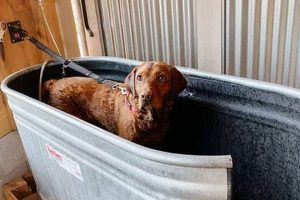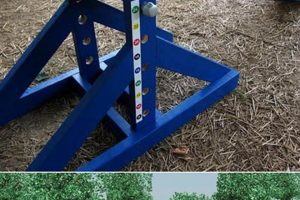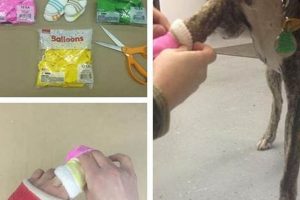Constructing a combination of elevated platforms with a resting area for canines represents a resourceful solution for pets needing assistance reaching higher surfaces, while also providing a comfortable space for relaxation. Such a project typically involves crafting a series of graduated steps or a ramp integrated with a cushioned area, effectively addressing mobility limitations and offering a dual-purpose piece of pet furniture.
This endeavor offers several benefits, including enhanced accessibility for small, elderly, or recovering dogs to furniture like beds and sofas, mitigating strain on their joints and preventing potential injuries. Moreover, the integration of a bed component allows the pet to feel secure and comfortable, promoting rest and alleviating anxiety. Historically, owners have sought inventive ways to improve their pets’ quality of life, and this type of construction aligns with that tradition by providing practical and comforting solutions.
The subsequent sections will explore the materials commonly used in this type of construction, provide detailed guidance on design considerations, and outline the necessary steps for assembly, ensuring a successful and safe outcome for the pet.
Construction Advice
The following recommendations are designed to assist in creating a safe, functional, and durable elevated platform system with integrated resting area for canines. Adherence to these suggestions will contribute to the overall success of the project.
Tip 1: Material Selection: Prioritize non-toxic and durable materials such as solid wood or reinforced plywood for the structural components. Avoid materials that splinter easily or contain harmful chemicals. Consider the weight-bearing capacity of the materials in relation to the dog’s size and weight.
Tip 2: Accurate Measurement: Precise measurements of the target furniture height (bed, sofa, etc.) are essential. Divide the total height by the desired number of steps to determine the optimal step height. This ensures ease of use and prevents strain on the animal.
Tip 3: Stable Base Design: A wide and stable base is critical for preventing tipping or wobbling. Consider incorporating non-slip feet or rubber pads to enhance stability, particularly on smooth surfaces.
Tip 4: Secure Fasteners: Employ high-quality screws, nails, or wood glue to securely fasten all components. Reinforce joints with corner braces or dowels for added strength and stability. Regularly inspect fasteners for loosening over time.
Tip 5: Gradual Incline and Step Depth: Design the steps with a shallow incline and adequate step depth to allow for comfortable and safe ascent and descent. Narrow or steep steps can discourage use and pose a risk of injury.
Tip 6: Bed Integration: Ensure the integrated resting area is appropriately sized for the dog. Use a comfortable and supportive cushion or mattress made of pet-safe materials. Secure the bed component to prevent it from sliding off the structure.
Tip 7: Surface Treatment: Apply a non-toxic sealant or finish to protect the wood from moisture and wear. Consider adding carpet or textured surfaces to the steps to improve traction and prevent slipping.
Tip 8: Safety Considerations: Round all sharp edges and corners to prevent injury. Avoid using small parts or decorations that could be chewed or ingested by the animal. Regularly inspect the structure for signs of damage or wear.
By implementing these tips, the resulting structure should provide a safe, accessible, and comfortable solution for pets requiring assistance with mobility.
The following sections will delve into customization options and address potential challenges encountered during construction.
1. Dimensions
Dimensional accuracy is paramount in the construction of an elevated platform system with integrated resting area for canines. Improperly sized steps or bed areas can negate the intended benefits of improved accessibility and comfort, potentially leading to injury or disuse. The following considerations address key facets of dimensional accuracy in this project.
- Overall Height and Step Count
The overall height must correspond precisely to the target elevation (e.g., bed height, sofa seat). The number of steps must be determined in relation to this total height, ensuring each step is a manageable and comfortable height for the dog. Insufficient steps result in excessively high individual steps, while too many steps necessitate an impractical length. A common approach is to use 6-inch steps; adjusting that height will define the step numbers.
- Step Depth and Width
Step depth dictates the amount of surface area available for the dog’s paws. Insufficient depth compromises stability, increasing the risk of slips or falls. Conversely, excessive depth can make the structure unwieldy. Similarly, the width must accommodate the dog’s stance and turning radius. Smaller dogs require less width than larger breeds. An example is the step depth of 10 inch wide, will prevent the pets from falling.
- Bed Area Size
The dimensions of the integrated resting area must accommodate the dog’s full body length and width when lying down. A bed area that is too small restricts movement and comfort, negating the purpose of this feature. Measurements should be taken with the dog in a natural resting position to ensure adequate space. The dog should be able to sleep comfortably and safely.
- Ramp Angle (If Applicable)
In lieu of steps, a ramp may be incorporated. The angle of inclination is critical. Excessive angles are difficult to navigate, while insufficient angles necessitate an unfeasibly long ramp. The appropriate angle depends on the dog’s physical condition and stride length. For example, steeper angles can lead to safety concerns.
Accurate measurement and careful consideration of these dimensional aspects are essential to achieving a functional and safe structure. Deviations from these standards can compromise the effectiveness of the “DIY dog steps bed”, rendering it unsuitable for its intended purpose.
2. Material Safety
Material safety is a paramount consideration in the construction of an elevated platform system with an integrated resting area for canines. The selection of appropriate materials directly impacts the animal’s health and well-being, as prolonged exposure to harmful substances can result in adverse health effects. This discussion will explore several critical facets of material safety in this context.
- Toxicity of Wood Treatments
Many wood treatments, such as paints, stains, and sealants, contain volatile organic compounds (VOCs) and other toxic chemicals. These substances can off-gas over time, releasing harmful fumes that can be inhaled or ingested by the dog. It is imperative to select wood treatments specifically labeled as non-toxic and pet-safe, ensuring they are free from lead, formaldehyde, and other hazardous substances. A common example is using water-based paints and finishes labeled as VOC-free.
- Fabric and Cushioning Composition
The materials used for the integrated resting area’s cushion and fabric coverings must also be carefully considered. Synthetic fabrics and certain types of foam may contain flame retardants, phthalates, and other potentially harmful chemicals. Opting for natural, hypoallergenic fabrics such as organic cotton or hemp, and using fillings like buckwheat hulls or shredded natural latex, minimizes the risk of allergic reactions and exposure to toxins. The choice of materials contributes to the pet’s well-being.
- Fastener Composition and Safety
The selection of fasteners, such as screws, nails, and adhesives, is equally important. Certain metal alloys can leach heavy metals, while some adhesives contain harmful solvents. Stainless steel fasteners are a safer alternative, as they are resistant to corrosion and do not leach harmful substances. Similarly, using non-toxic wood glue ensures secure assembly without compromising the pet’s health. Securing all the part of the contruction will prevent any physical hazard.
- Potential for Allergen Exposure
Materials can harbor allergens, such as dust mites and mold spores, which can trigger allergic reactions in sensitive animals. Regularly cleaning the structure and using hypoallergenic materials can mitigate this risk. Moreover, selecting materials that are resistant to moisture and mold growth helps to maintain a healthy environment for the pet. Cleaning regularly will prevent many health problems.
Therefore, a thorough evaluation of material safety is essential in the construction of a “DIY dog steps bed.” Prioritizing non-toxic, hypoallergenic, and durable materials ensures the structure is not only functional but also promotes the health and well-being of the canine using it. Considering the components, like the glue that is used, will ensure its safety.
3. Structural Integrity
The long-term utility and safety of a DIY elevated platform with resting area for canines are intrinsically linked to its structural integrity. A robust design and careful execution are essential to prevent collapse, instability, or premature failure, all of which pose significant risks to the animal.
- Load-Bearing Capacity
The structure must withstand the dog’s weight without deformation or failure. This necessitates careful calculation of the load-bearing capacity of each component, accounting for the dog’s weight and any potential dynamic forces (e.g., jumping). For instance, using thin plywood for the steps of a large breed dog is inadequate, leading to potential collapse. Reinforcing structural members based on anticipated weight distribution is critical for ensuring safe use.
- Joint Strength and Stability
The connections between individual components must be sufficiently strong and stable to resist shearing, bending, and torsional forces. Weak joints can lead to wobbling, instability, and eventual separation of parts. Proper joinery techniques, such as using screws, dowels, or mortise-and-tenon joints, combined with appropriate adhesives, are essential. Insufficiently secured joints represent a major point of failure.
- Material Selection and Durability
The choice of materials significantly impacts the structure’s overall integrity and lifespan. Durable materials, such as solid wood or high-grade plywood, are less prone to cracking, warping, or splintering. Selecting materials appropriate for the intended environment, considering factors such as moisture and humidity, is also crucial. For example, using untreated softwood in a damp environment can lead to rot and structural weakening.
- Base Stability and Support
The base of the structure must provide a stable and level foundation to prevent tipping or rocking. A wide base and strategically placed supports distribute the weight evenly, reducing stress on individual components. Utilizing non-slip feet or pads can further enhance stability, particularly on smooth surfaces. An unstable base compromises the entire structure’s safety.
These facets collectively determine the safety and longevity of the elevated platform with resting area. Inadequate attention to any of these structural elements can compromise the entire project, potentially resulting in injury to the animal or premature failure of the structure. It is imperative, therefore, to prioritize structural integrity throughout the design and construction process.
4. Step Incline
The angle of ascent, referred to as step incline, is a critical design parameter directly impacting the accessibility and safety of elevated platforms constructed for canine use. The gradient significantly affects the effort required for the animal to navigate the structure and influences the potential for strain or injury.
- Joint Stress Mitigation
A shallow incline minimizes stress on the joints, particularly in elderly, arthritic, or recovering dogs. Steeper inclines necessitate greater muscle exertion and joint flexion, potentially exacerbating existing conditions. A gradual incline allows for a more natural gait and reduces the risk of overextension. For instance, a ramp with a very steep incline, will cause much physical stress.
- Accessibility for Small Breeds
Smaller dog breeds or those with short legs may struggle with steeper inclines due to limited stride length. An excessively steep ascent can be insurmountable, rendering the structure unusable. A less severe angle facilitates easier navigation and ensures the platform is accessible to dogs of varying sizes and physical capabilities. For safety concerns, there should be a focus on the breeds’ physical well-being.
- Prevention of Slipping and Falls
A moderate incline, combined with appropriate surface traction, minimizes the risk of slipping and falls. Steep inclines, particularly when coupled with smooth surfaces, increase the likelihood of the animal losing its footing. Designing the step or ramp with sufficient friction and a manageable angle enhances stability and prevents injuries. The degree of safety will vary.
- Accommodation of Physical Limitations
Dogs with physical limitations, such as visual impairments or neurological conditions, may have difficulty navigating steep or uneven surfaces. A consistent and gradual incline provides a predictable and stable pathway, reducing the risk of disorientation or stumbling. Addressing the gradient will greatly contribute to pets’ safety.
Therefore, the precise determination of step incline is a vital consideration in “DIY dog steps bed” design. Prioritizing a shallow and consistent angle of ascent, combined with appropriate surface materials, enhances accessibility, minimizes stress on joints, and reduces the risk of injury, contributing to the overall safety and usability of the structure for canines with diverse physical capabilities.
5. Cushion Comfort
Cushion comfort is an essential component of the utility and appeal of elevated platforms with integrated resting areas for canines. The presence of adequate cushioning directly influences the animal’s willingness to use the structure, transforming it from a mere set of steps into a functional and desirable resting space. A lack of comfort leads to the animal avoiding the bed component, negating the intended dual purpose of the structure. For example, if the steps are well-constructed, but the cushioning is thin or made of an unappealing material, the dog may choose to remain on the floor or seek a more comfortable resting place elsewhere.
The choice of cushioning material affects the level of support provided, which is particularly crucial for dogs with joint problems or mobility issues. Dense foam or memory foam provides better support and pressure distribution compared to thinner, less supportive materials. Furthermore, the fabric covering the cushion must be durable, easy to clean, and non-irritating to the dog’s skin. For instance, a dog with sensitive skin may react negatively to a cushion covered in synthetic fibers, leading to discomfort and skin irritation. Pet owners should ensure their dog’s physical comfort and safety.
In summary, cushion comfort is inextricably linked to the success of a “DIY dog steps bed”. It is not merely an aesthetic consideration but a functional requirement that determines whether the structure will serve its intended purpose. Challenges arise in selecting the right balance of support, durability, and ease of maintenance. However, attention to these factors ensures the resulting structure provides both accessibility and a comfortable resting space for the canine companion.
6. Non-Slip Surface
The incorporation of a non-slip surface is a critical safety feature in the design and construction of “DIY dog steps bed.” Its absence can directly contribute to accidents, particularly slips and falls, resulting in injuries to the animal. The relationship between the surface traction and the structure’s usability is a direct cause-and-effect scenario: inadequate grip leads to instability, increasing the risk of harm. The importance of a non-slip surface is amplified for dogs with mobility challenges, such as geriatric canines or breeds predisposed to joint problems. For example, a set of steps constructed with a smooth, varnished wood surface presents a significant hazard, especially when wet or when used by a dog with limited coordination. A non-slip surface is, therefore, a fundamental component influencing the efficacy and safety of the structure.
Practical applications of this understanding involve careful selection of surface materials. Common solutions include the application of textured coatings, the installation of carpet treads, or the use of rubberized mats on each step. The choice depends on factors such as aesthetics, durability, and ease of cleaning. However, the underlying principle remains constant: the surface must provide sufficient friction to prevent slippage during ascent and descent. This is especially critical in environments where the steps may be exposed to moisture. Another consideration is the type of non-slip material. For example, some carpet treads will wear quickly with constant use. Similarly, some rubberized mats can emit odors or be difficult to clean. Experimenting with different materials is part of ensuring long-term safety.
In summary, the integration of a non-slip surface is non-negotiable for a safe and functional “DIY dog steps bed.” The absence of this feature poses a direct risk of injury, particularly for vulnerable animals. Challenges may arise in balancing the need for adequate traction with aesthetic preferences or ease of maintenance. However, prioritizing safety through careful material selection and surface treatment is paramount. The understanding and application of this principle directly contribute to the well-being of the canine companion utilizing the structure. Pet’s safety relies on many important components.
7. Overall Stability
The concept of overall stability is of critical importance in the context of a self-constructed elevated platform with a resting area for canines. It directly influences the safety and longevity of the structure, dictating its ability to withstand regular use without collapsing or becoming hazardous. Several key facets contribute to this overall stability, each demanding careful consideration during the design and construction phases.
- Base Support Area
The area of the base in contact with the ground directly impacts the structure’s resistance to tipping. A wider base provides a lower center of gravity, increasing stability. For instance, a narrow base on a tall structure is more prone to toppling, particularly with the dynamic forces exerted by a dog climbing or jumping onto it. A sufficient support area is, therefore, fundamental for preventing accidents.
- Weight Distribution
Even weight distribution throughout the structure is essential for preventing localized stress points that could lead to failure. Uneven weight distribution can occur if one side is significantly heavier than another, or if the load-bearing components are not adequately supported. This principle dictates the placement of support beams and the selection of materials to ensure each part of the structure can handle its designated load. As an example, if the structure features only three contact points on the floor, uneven terrain will decrease stability compared to a four-point base.
- Material Strength and Rigidity
The materials used in construction must possess sufficient strength and rigidity to resist bending, warping, or cracking under load. High-quality wood, reinforced plywood, or metal frameworks are commonly employed for their structural properties. Choosing materials inappropriate for the weight and activity level of the dog can compromise the structure’s integrity. For instance, using thin particleboard for the steps of a large breed dog is likely to result in collapse over time. As an example, the type of material should be chosen to withstand normal wear and tear.
- Joint Integrity
The manner in which individual components are connected is critical for maintaining overall stability. Weak or poorly executed joints can become points of failure, leading to instability and potential collapse. Secure fastening methods, such as screws, bolts, or strong adhesives, combined with appropriate joinery techniques, are necessary to ensure the structure remains intact over time. When building this structure, it is important to make sure that it is properly assembled and attached.
In summary, overall stability is a multifaceted attribute of a “DIY dog steps bed” that depends on careful consideration of base support, weight distribution, material properties, and joint integrity. Neglecting any of these factors can compromise the structure’s safety and longevity. By prioritizing these aspects, creators can ensure the final product is a safe and functional addition to the home.
Frequently Asked Questions
The following questions and answers address common concerns and provide clarification regarding the construction and utilization of canine elevated platforms incorporating a resting area.
Question 1: What is the optimal angle of incline for ramps incorporated into these structures?
The ideal incline varies based on the dog’s size, breed, and physical condition. However, a general recommendation is to maintain a slope no steeper than 25 degrees to minimize joint strain and prevent slipping.
Question 2: What type of wood is best suited for building a dog steps bed, considering safety and durability?
Hardwoods like maple or oak offer superior durability, but may be more expensive. Pine is a cost-effective alternative. Regardless of the choice, ensure the wood is untreated with harmful chemicals and properly sealed to prevent splintering.
Question 3: How can the structure be effectively cleaned and maintained to prevent odors and allergens?
Regular vacuuming is crucial for removing pet hair and dander. Removable and washable cushion covers are highly recommended. Periodically disinfecting the wooden surfaces with a pet-safe cleaning solution helps eliminate odors and allergens.
Question 4: What is the recommended weight limit for an elevated platform with an integrated resting area?
The weight limit depends on the materials and construction methods used. As a general guideline, the structure should be able to safely support at least twice the dog’s weight. Reinforcing the structure with additional supports is advisable for larger breeds.
Question 5: How can the structure be adapted for dogs with visual impairments?
Applying contrasting colored tape to the edges of each step provides visual cues. Ensuring adequate lighting around the structure also aids navigation. Maintaining a consistent layout and avoiding changes to the environment are beneficial.
Question 6: What safety precautions should be taken during the construction process?
Wearing safety glasses and gloves is essential when cutting or sanding wood. Ensuring proper ventilation when using adhesives or sealants minimizes exposure to harmful fumes. Following all manufacturer’s instructions for tools and materials is critical.
These answers provide essential guidance for safely and effectively constructing and utilizing these structures, emphasizing the importance of proper design, material selection, and maintenance.
The subsequent section will provide a step-by-step construction guide, offering detailed instructions for building a basic elevated platform with an integrated resting area.
Conclusion
The preceding analysis has thoroughly examined the critical aspects of constructing a “DIY dog steps bed,” underscoring the necessity of careful planning, material selection, and execution. Factors such as structural integrity, step incline, and material safety are not mere suggestions, but rather essential elements dictating the functionality and safety of the resulting structure. These considerations directly impact the canine’s well-being and the long-term viability of the project.
Owners are encouraged to prioritize these guidelines, ensuring that such a project serves its intended purpose of enhancing the pet’s accessibility and comfort. The informed application of these principles will result in a valuable asset, promoting the health and happiness of the canine companion for years to come.







